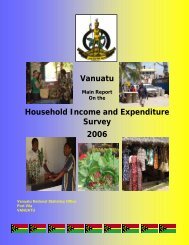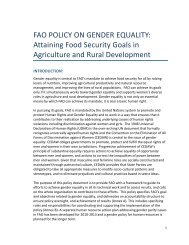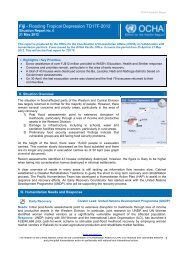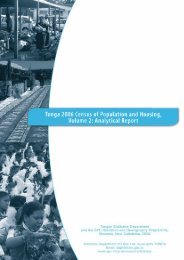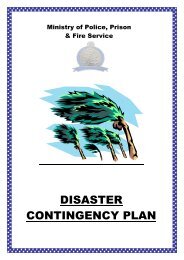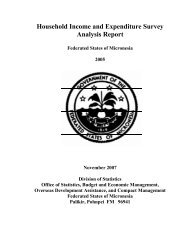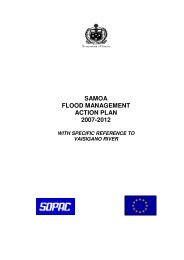Solomon Islands - Asia & the Pacific
Solomon Islands - Asia & the Pacific
Solomon Islands - Asia & the Pacific
Create successful ePaper yourself
Turn your PDF publications into a flip-book with our unique Google optimized e-Paper software.
<strong>Solomon</strong> <strong>Islands</strong>: Analysis of Poverty from 2005/2006 HIESvalidates <strong>the</strong> data in Table 6 indicating <strong>the</strong> very low level of own consumption by Honiara HH, and despite <strong>the</strong>lower unit-values of rural own production, <strong>the</strong> much higher total value of own food production in <strong>the</strong> rural areas.114. Charts 13 and 14 show <strong>the</strong> principal activities of Honiara and rural households by top and bottom three decilesand by <strong>the</strong> sex of household head. These charts show <strong>the</strong> importance of being in some form of work as a basis forbeing not-poor, especially in <strong>the</strong> rural areas. In Honiara those working full or part-time are almost as likely to be in<strong>the</strong> lowest as in <strong>the</strong> highest three deciles. This suggests that many are working full-time on very low rates of pay.However working for household consumption is likely to be associated with being below <strong>the</strong> poverty line whilein <strong>the</strong> rural areas this activity could be associated with being in <strong>the</strong> top three deciles.115. Being unemployed (defined as though available and looking for work) was recorded as <strong>the</strong> situation for 11.8% ofall HH heads in Honiara and for 20.1% and 25.0% of HH heads in <strong>the</strong> provincial-urban and rural areas respectively.However for those in <strong>the</strong> lowest three deciles <strong>the</strong> proportions were 14.7% for Honiara HH, 23.8% of provincialurbanHH heads and 23.4% of those in <strong>the</strong> rural areas. Thus it would seem that <strong>the</strong> continuing migration into <strong>the</strong>Honiara urban centre is a rational response to <strong>the</strong> fact that unemployment is much more likely in <strong>the</strong> rural andprovincial-urban areas than in Honiara.116. However as <strong>the</strong> Charts show households with unemployed heads are more likely to be in <strong>the</strong> bottom three decilesin both Honiara and <strong>the</strong> rural areas. The problem of unemployment extends through <strong>the</strong> whole population. Thelevel of unemployment is especially high in <strong>the</strong> rural areas where one-third of all males and all females in <strong>the</strong>lowest three deciles reported as being unemployed.117. In contrast only 4.9% of rural males and 1.5% of rural females reported as being in full time employment. In Honiara32.0% of males in <strong>the</strong> lowest three deciles reported as working full time, as did 19.3% of all Honiara females.118. Fur<strong>the</strong>r details of economic activity by gender and by location are provided in Appendix Tables A12 through A15,covering Honiara and <strong>the</strong> rural areas.7.6 Educational Attainment119. Charts 15, 16 and 17 show <strong>the</strong> highest educational levelattained by heads of households in Honiara and <strong>the</strong> ruralareas, fur<strong>the</strong>r details are provided in Appendix Tables A2 forrural households and A3 for Honiara households, In <strong>the</strong> ruralareas 21.5% of household heads in <strong>the</strong> lowest three decileshave no education compared with only 7.3% of those in <strong>the</strong>highest three deciles. In Honiara by comparison, only 4.7% of<strong>the</strong> poorest HH heads and 1.7% of those in <strong>the</strong> highest threedeciles had no education.Chart 15Educational Attainment of HH Heads: Hoiara HH by Decile120. Of those rural HH heads with only primary level education<strong>the</strong>re was little difference between <strong>the</strong> lowest and highest50No GradeNo Grade Secondary Post Secondarythree deciles; in both groups <strong>the</strong> proportion was aroundLowest Three Deciles Highest Three Deciles52%. In Honiara <strong>the</strong>re was however a significant differencewith 43.5% of <strong>the</strong> lowest three deciles and only 9.4% of <strong>the</strong> highest three deciles reaching only primary level.At secondary level <strong>the</strong>re was little difference in <strong>the</strong> attainment level in Honiara, but <strong>the</strong> poorest rural HH heads% of HH50454035302520151034Estimation of National Poverty Lines and Poverty Incidence





